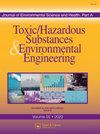Phosphate removal using dolomite modified with ultrasound: mathematical and experimental analysis.
IF 1.9
4区 环境科学与生态学
Q4 ENGINEERING, ENVIRONMENTAL
Journal of Environmental Science and Health Part A-toxic\/hazardous Substances & Environmental Engineering
Pub Date : 2023-01-01
DOI:10.1080/10934529.2023.2196928
引用次数: 4
Abstract
Abstract We studied the dolomite modified using an ultrasound bath and its application in phosphate removal. The modification was applied to improve the physicochemical properties of the dolomite and then to enhance its suitability as an adsorbent solid. The settings for analyzing the adsorbent modification were bath temperature and sonication time. The modified dolomite was characterized by electron microscopy, N2 adsorption/desorption, pore size, and X-ray diffraction. To grasp the pollutant’s adsorption mechanism more precisely, we used experimental research and mathematical model analysis. Design of Experiments was conducted to determine the ideal circumstances. In addition, the Bayesian method of Markov Chain Monte Carlo was used to estimate the isotherm and kinetic model parameters. A thermodynamic study was done to investigate the adsorption mechanism. Results show that the surface area of the modified dolomite was greater, enhancing its adsorption properties. To remove more than 90% of the phosphate, the optimal operational parameters for the adsorption were pH 9, 1.77 g of adsorbent mass, and 55 minutes of contact time. The pseudo-first-order, Redlich–Peterson and Sips models presented a good fit to the experimental data. Thermodynamics suggested a spontaneous and endothermic process. The mechanism suggested that physisorption and chemisorption could be involved in phosphate removal.用超声改性白云石去除磷酸盐:数学和实验分析。
研究了超声浴改性白云石及其在除磷中的应用。通过对白云石进行改性,改善了白云石的理化性质,提高了其作为吸附剂的适用性。分析吸附剂改性的设置为浴温和超声时间。通过电镜、N2吸附/解吸、孔隙大小和x射线衍射对改性白云石进行了表征。为了更准确地掌握污染物的吸附机理,我们采用了实验研究和数学模型分析相结合的方法。进行了实验设计,以确定理想的环境。此外,采用马尔可夫链蒙特卡罗贝叶斯方法估计了等温线和动力学模型参数。对吸附机理进行了热力学研究。结果表明,改性后的白云石表面积增大,吸附性能增强。为了达到90%以上的磷酸盐去除率,最佳吸附操作参数为pH为9,吸附剂质量为1.77 g,接触时间为55 min。伪一阶、Redlich-Peterson和Sips模型与实验数据拟合良好。热力学表明这是一个自发的吸热过程。其机理表明,物理吸附和化学吸附可能参与了磷酸盐的去除。
本文章由计算机程序翻译,如有差异,请以英文原文为准。
求助全文
约1分钟内获得全文
求助全文
来源期刊
CiteScore
4.10
自引率
4.80%
发文量
93
审稿时长
3.0 months
期刊介绍:
14 issues per year
Abstracted/indexed in: BioSciences Information Service of Biological Abstracts (BIOSIS), CAB ABSTRACTS, CEABA, Chemical Abstracts & Chemical Safety NewsBase, Current Contents/Agriculture, Biology, and Environmental Sciences, Elsevier BIOBASE/Current Awareness in Biological Sciences, EMBASE/Excerpta Medica, Engineering Index/COMPENDEX PLUS, Environment Abstracts, Environmental Periodicals Bibliography & INIST-Pascal/CNRS, National Agriculture Library-AGRICOLA, NIOSHTIC & Pollution Abstracts, PubSCIENCE, Reference Update, Research Alert & Science Citation Index Expanded (SCIE), Water Resources Abstracts and Index Medicus/MEDLINE.

 求助内容:
求助内容: 应助结果提醒方式:
应助结果提醒方式:


